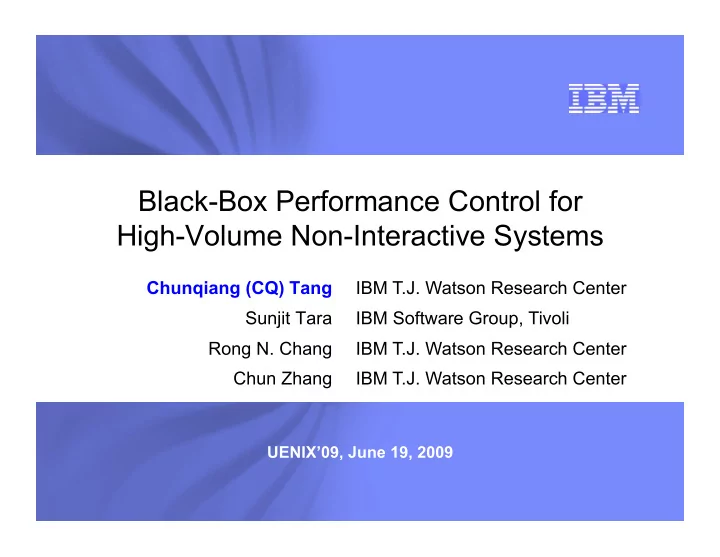

IBM Research Black-Box Performance Control for High-Volume Non-Interactive Systems Chunqiang (CQ) Tang IBM T.J. Watson Research Center Sunjit Tara IBM Software Group, Tivoli Rong N. Chang IBM T.J. Watson Research Center Chun Zhang IBM T.J. Watson Research Center UENIX’09, June 19, 2009
IBM Research Response Time Driven Performance Control for Interactive Web Applications Interactive users are sensitive to sub-second response time Naturally, performance control is driven by response time ▶ E.g, stop admitting new requests if response time exceeds a threshold ▶ Well studied area: admission control, service differentiation, etc. 2 2
IBM Research But there are Robots that Impact Perf Control Many Web services also provide APIs to explicitly work with robots ▶ Twitter API Traffic was 10x of its Web traffic Some applications work with interactive users during daytime, and then are driven by robot tools at nights to perform heavy-duty analytics How robots impact performance control ▶ They often have tons of work to do and hence are throughput centric ▶ They may not require sub-second response time, e.g., crawler and analytics 3 3
IBM Research IT Monitoring and Mgmt: a World where Robots Rule Data center Before an IT service mgmt system (ITSM) can manage a data center, it must manage itself well ▶ Withstand event flash crowd triggered by, e.g., router failure ▶ Achieve high event-processing throughput by driving up resource utilization ▶ Avoid resource saturation as sysadmins may want to do manual investigation 4 4
IBM Research Simplified View of IBM Tivoli Netcool/Impact It provides a reusable framework for integrating all kinds of siloed monitoring and mgmt tools It is built atop a J2EE engine but cannot use response-time driven performance control 5 5
IBM Research Why Perf Control is Difficult in Netcool/Impact Work with third-party software provided by many vendors We cannot greedily maximize performance without considering congestion Bottleneck can be anything anywhere: CPU, disk, memory, network, etc. Bottleneck depends on how users write their code atop Netcool/Impact Not a simple static topology like web->app->DB No simple perf indicator like packet loss or response time violation 6 6
IBM Research Black-Box Approach: Throughput-guided Concurrency Control (TCC) Why not simply use TCP to maximize throughput ▶ We deal with general distributed systems rather than just network ▶ No packet loss as performance indicator ▶ Unlike router, a general server’s service time is not a constant 7 7
IBM Research Simplified State-Transition Diagram for Thread Tuning base state: reduce threads by w% add-thread state: repeatedly add threads so long as every p% increase in threads improves throughput by q% or more remove-thread state: repeatedly remove threads by r% each time so long as throughput does not decrease significantly 8 8
IBM Research Conditions for Friendly Resource Sharing Repeatedly add threads so long as every p% increase in threads improves throughput by q% or more e.g., double threads (p=100%) and then see thruput increases by q=1%. This is no good. Reduce threads by w% at the beginning of exploration The base state must be sufficiently low so that it will end up with less threads if resource is saturated 9 9
IBM Research Conditions for Friendly Resource Sharing If there is an uncontrolled competing program, NCI shares 44–49% of the bottleneck resource Two instances of NCI share bottleneck resources in a friendly manner However, three or more instances of NCI need coordination from the master 10 10
IBM Research Drive up Resource Utilization to Achieve High Throughput TCC is friendly but also sufficiently aggressive to drive up resource utilization 11 11
IBM Research Throughput Measurement 1: Exclude Idle Time from Throughput Calculation Throughput = Throughput = 12 12
IBM Research Throughput Measurement 2: Minimize Measurement Samples Minimize the number of measurement samples while ensuring a high probability of making correct decisions Problem formulation Solution 13 13
IBM Research Throughput Measurement 3: Exclude Outliers from Throughput Calculation Extreme activities such as Java garbage collection introduce large variance ▶ Sometimes GC can take as long as 20 seconds There are many known methods to handle outliers We found that simply dropping 1% of the largest samples works well This is simple but critical 14 14
IBM Research Experimental Setup In some experiments, we introduce extra network delay In some experiments, we control service time of the Web service and Netcool/Impact user scripts 15 15
IBM Research Scalability of NCI Cluster 16 16
IBM Research CPU as the Bottleneck Resource 17 17
IBM Research Recover from Memory Thrashing 18 18
IBM Research Disk as the Bottleneck Reducing threads actually improves disk performance 19 19
IBM Research Work with an Uncontrolled Competing Program 20 20
IBM Research Related Work Greedy parameter search ▶ Too greedy without considering resource contention TCP-style congestion control, e.g., TCP Vegas ▶ Assume minimum RTT is the mean service time ▶ In DB, min response time is the best-case cache hit service time. It cannot be used to estimate the congestion-free baseline throughput. Control theory ▶ Not sufficiently black-box ▶ Need to monitor resource utilization if applied to Netcool/Impact Queueing theory ▶ Assume a known static topology and a known bottleneck 21 21
IBM Research Future Work Is it possible to get “TCP-friendly” for general distributed systems? ▶ Currently three or more instances of NCI need coordination in order to be friendly to each other Can we estimate the utilization of Google’s internal servers by observing changes in query response time? ▶ This is possible for restricted queuing models ▶ What’s the most general model for which this is still doable? 22 22
IBM Research Take Home Message We need to revisit performance control for systems that handle workloads generated by software tools (robots) ▶ Mixed human/robot worklaod (Twitter fits here) ▶ Mostly robot workload (Netcool/Impact fits here) ▶ Robot-only workload (Hardoop fits here) 23 23
Recommend
More recommend